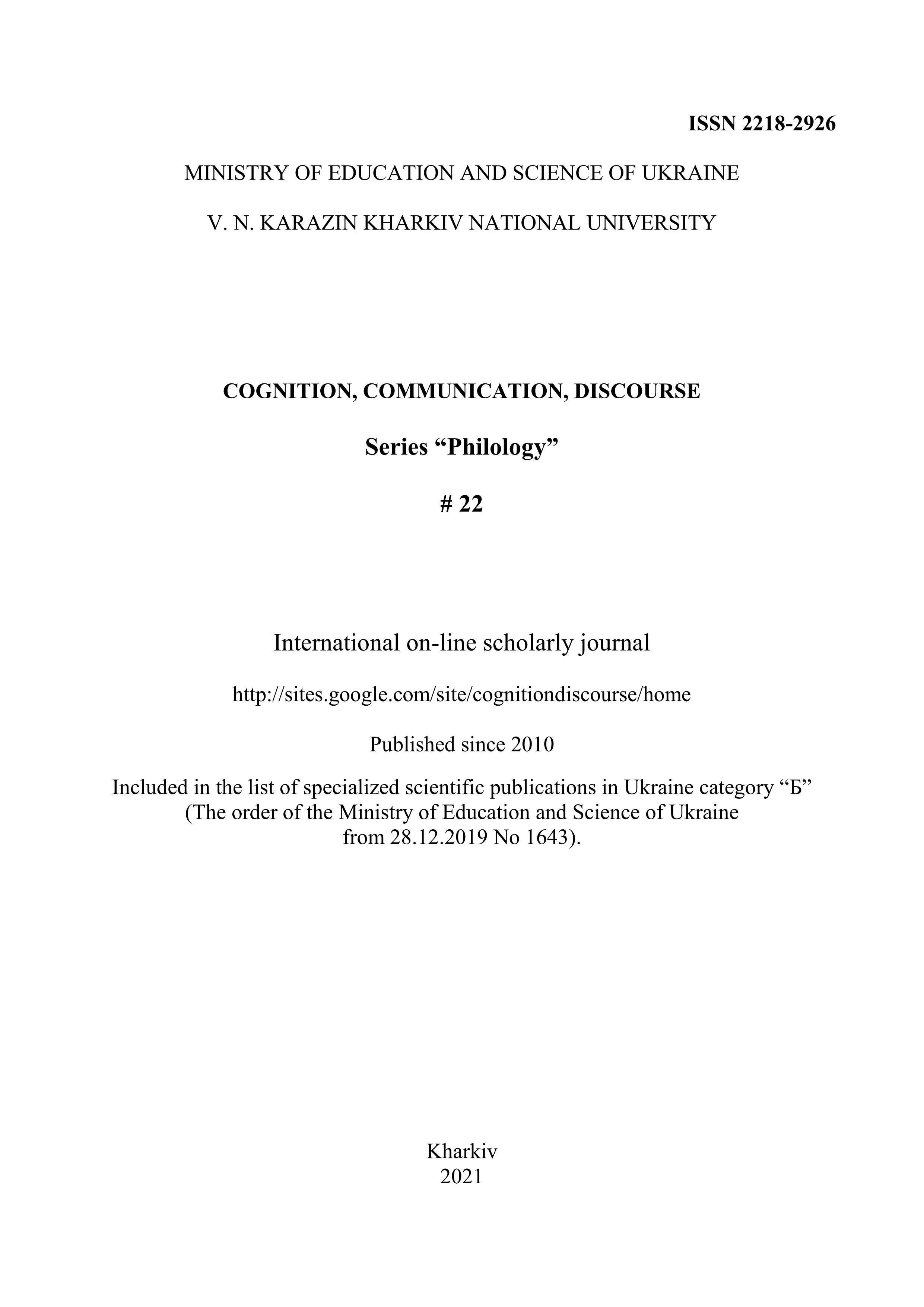The functions of heraldic symbols in the English fiction
Abstract
The article considers the main functions performed by heraldic symbols due to their verbalization in blazons as descriptions of coats of arms by a specific set of language constructs. Heraldic symbols as the quintessence of culture are analyzed in the communicative-functional aspect. There are some special characteristics of heraldic symbolic units, namely, their multifunctional orientation, the possibility of multiple interpretations, the presence of a nomination mechanism, and others. The mediative and mnemonic functions of symbols, taken from the works of Lotman, are manifested in the heraldic symbols of fiction as one of the mechanisms of cultural memory, therefore, the symbol is a mediator of the semiosis spheres. The list of functions is supplemented by the consideration of the social dimension, because heraldic symbols are potentiated in the society, therefore, the essence of the identification-integrative and adaptive-regulatory functions of heraldic symbolism is revealed. The concepts of multimodal imagery and synesthesia effect, which are embodied in the interaction of verbal and nonverbal symbols, are involved in the analysis of the blazons on the material of English fiction. The theme of symbols functioning is supplemented by the classification of the main functions and subfunctions proposed by the author. The focus of the study is also the identification function, resulting in an emphasis on the role of a special heraldic language in the expression of the personality. Taking into account the types of coats of arms, the article considers the coding function in the punning and allusive coats of arms, as well as in the heraldic lexemes borrowed from other languages. The cross-cutting idea of the article is revealed through the interpretation of heraldic symbols in their functioning in the works of English fiction and poetry and summarized in the definition of the symbol not only as a linguistic unit, but also as a semiotic phenomenon of culture.
Downloads
References
Aslamazishvili, D. N. (2007). Rol’ simvola v dukhovnykh protsessakh kul’turnogo perekhoda. [The role of symbol in the spiritual processes of cultural transference]. Unpublished candidate dissertation, Syberian aerospace academy, Krasnoyarsk, Russia (in Russian)
Averintsev, S. S. (2001). Sophia-Logos (2nd ed.) Кyiv: Dukh i Litera.
Barden, N., & Williams. Т. (2007). Words and symbols: language and communication in therapy. London: Open University Press.
Bortnik, O. I., & Rezko, I. V. (2008). Geral’dika mira [Heraldry of the world]. Minsk: Kharvest.
Chandler, D. (2007). Semiotics: the basics. London, New York: Routledge.
Egbert, J., Burch, B., & Biber, D. (2020). Lexical dispersion and corpus design. International Journal of Corpus Linguistics 25(1), 89–115. https://doi.org/10.1075/ijcl.18010.egb
Fernández, J. J., Eigmüller, M., & Börner, S. (2016). Domestic transnationalism and
the formation of pro-European sentiments. European Union Politics, 17, 457–81. https://doi.org/10.1515/9783110627275-007
Fox-Davies, A.C. (2007). A Complete Guide to Heraldry. New York, N.Y.: Skyhorse Publishing.
Hardy, M. (2018). The Shields that Guard the Realms of Men: Heraldry in Game of Thrones. Genealogy, 2(4), 48. https://doi.org/10.3390/genealogy2040048
Karmadonov, O. A. (1998). Semantika politicheskogo prostranstva: opyt krosskul’turnogo transsimvolicheskogo analiza [Semantics of political space: the experience of cross-cultural transsymbolic analysis]. Zhurnal sociologii i social’noj antropologii, 1(4), 34-39.
Kretov, P. V. (2000). Hnoseolohichnyi aspect filosofs’koho symvolizmu [The gnoseological aspect of philosophic symbolism]. Unpublished candidate dissertation thesis, South Ukrainian National Pedagogic University named after K. D. Ushynsky, Odessa, Ukraine (in Ukrainian)
Losev, A. F. (1995). Problema simvola i realisticheskoe iskusstvo [The problem of symbol and realistic art]. Moskva: Iskusstvo.
Lotman, Iu. M. (2001). Semiosfera [Semiosphere]. Sankt-Peterburg: Iskusstvo.
Meyer, L. (2020). Family History: Fact versus Fiction. Genealogy, 4(2), 44. https://doi.org/10.3390/genealogy4020044
Pimbley, A. F. (n.d.). Dictionary of heraldry. http://www.luz-herald.net/free/lettres.html
Sebeok, Th. A. (2001). Signs: An introduction to semiotics (2d ed.). Toronto, Buffalo, London: University of Toronto Press.
Shaw, E. (2020). “Who we are and why we do it”: A demographic overview and the cited motivations of Australian family historians. Journal of Family History, 45, 109–24. https://doi.org/10.1177/0363199019880238
Shevchenko, I. S. (2019). Enactive meaning-making in the discourse of theatre and film. Cognition, communication, discourse, 19, 15-19. DOI: 10.26565/2218-2926-2019-19-01
Shevchenko, I. (2017). Had We Never Loved So Kindly: Conceptualisation of communicative behavior. In E. Chrzanowska-Kluczewska, & O. Vorobyova (Eds.) Language – Literature – the Arts: A Cognitive-Semiotic Interface. Series: Text – meaning – context: Cracow Studies in English Language, Literature and Culture. (pp. 307-320). Frankfurt-am-mein: Peter Lang. https://doi.org/10.3726/b10692
Torop, P. (2019). The textual issues of meaning-making in theatre and film: a semiotic introduction. Cognition, communication, discourse, 19, 20-28. https://doi.org/10.26565/2218-2926-2019-19-02
Wade, W. C. (1989). The Symbolisms of Heraldry. London: George Redway.
Copyright (c) 2021 Iuliia Moiseiuk

This work is licensed under a Creative Commons Attribution-NonCommercial-NoDerivatives 4.0 International License.
Authors, who publish with this journal, accept the following conditions:
The authors reserve the copyright of their work and transfer to the journal the right of the first publication of this work under the terms of the Creative Commons Attribution License (CC BY), which allows other persons to freely distribute a published work with mandatory reference to the authors of the original work and the first publication of the work in this journal.
Authors have the right to enter into separate additional agreements for the non-exclusive dissemination of the work in the form in which it was published by this journal (for example, to post the work in the electronic institutions' repository or to publish as part of a monograph), provided that the link to the first publication of the work in this journal is given.
The journal policy allows and encourages the authors to place the manuscripts on the Internet (for example, in the institutions' repositories or on personal websites), both before the presentation of this manuscript to the editorial board and during review procedure, as it contributes to the creation of productive scientific discussion and positively affects the efficiency and dynamics of citing the published work (see The Effect of Open Access).




